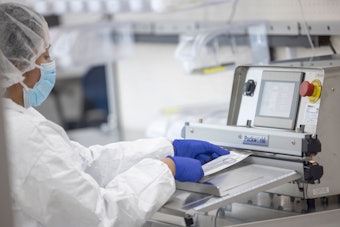Today, overall equipment effectiveness (OEE) is one of the most common metrics used in manufacturing. Seiichi Nakajima introduced the concept in October 1989 in his book Introduction to TPM: Total Productive Maintenance. It serves as one of the cornerstones for total productive maintenance (TPM)
In the book, Nakajima explains the primary goal of TPM is to achieve zero defects and breakdowns for each manufacturing machine or asset. Another key objective in the framework is reducing the probability of equipment breakdowns and potentially defective products. It is here that OEE becomes a key metric.
Nakajima observed that reduced breakdowns and defects can help cut costs, improve inventory, and increase production rates. In this context, OEE is an instrumental metric for providing continual feedback on manufacturing performance at the machine level. Manufacturers can course-correct their production strategies and gain the maximum productivity per machine. Multiplying machine availability by performance by quality calculates the OEE metric. Thus, OEE measures the gap between optimal production levels and actual production run rates at the machine level.
OEE is not a panacea. Critics point out that a given manufacturing plant could have a perfect OEE score but suffer quality problems and miss delivery dates. Moreover, there is a glaring weakness in OEE’s inability to consider manufacturing operations as an integrated ecosystem. One that can adapt and flex in real time and learn physics or measurable performance over time.
OEE was never designed to provide deeper contextual intelligence. When combined with other metrics and key performance indicators (KPIs) it can powerfully improve shop floor visibility. Additionally, OEE has proven to be a scalable and valuable metric for determining the success of a lean manufacturing and maintenance program.
OEE’s Role in Industry 4.0
For manufacturers, the pragmatic value of OEE, despite its limitations, is identifying when a machine has the potential for equipment failure. Companies can prolong the life of production assets by taking prescriptive measures when detecting machinery wear. Most manufacturers I’ve spoken with rely on OEE metrics as a KPI included in their reporting dashboards for managing production operations.
It’s clear that OEE adoption is growing, especially for tracking Industry 4.0 performance gains to the machine level. In an era of smart, connected machinery, real-time production and process monitoring goes hand-in-hand with OEE. The more granular real-time data that a machine can provide, the more job- and task-level visibility and control the manufacturer receives.
OEE is enabling new levels of efficiency and production capacity across a range of industries. Its biggest impact is yet to come as equipment manufacturers evolve their business models.
Machine Monitoring OEE and the move toward OEM data-based services
As machinery moves toward greater commoditization, OEMs will need to add software services to grow business and profitability. McKinsey outlines this industry shift in its report, “Digital Machinery: How companies can win the changing manufacturing game.”
According to the McKinsey report, digital machinery means a shift from “hardware only” to “hardware, software, and services.” Together this enables the development of new business models. For example, on top of its own smart factory, an engineering company might also establish a smart-machine-based new business model. This enables new service offers, such as predictive maintenance. Digitization also makes output-based business models possible, which would be the basis for offers such as guaranteed machine performance.
In the emerging world of machinery data-based services, OEMs will tie data and software services to revenues and customer satisfaction. It will help customers keep their machines running and minimize any maintenance-related disruptions to the business. When OEMs provide customers with monitoring and managing services, OEE will play a central role in capturing machine health metrics. The three key dimensions are availability, performance, and quality.
Nakajima designed OEE into TPM to track productivity losses due to downtime (availability), speed losses (performance), and defects (quality). The OEE equation captures the most quantifiable factors of each area. Further, two components of availability provide additional measures of how effective a given machine is at any time. They are unplanned downtime (UDT) and planned downtime (PDT).
In a services-based business model, real-time production and process monitoring provides essential data for getting OEE right to the machine level. At the same time, a services-based business model needs an integrated network to use machinery data.
Smart, connected machines can provide the real-time data needed for implementing statistical process control (SPC) and capturing metrics. Metrics can include accurate mean time to repair (MTTR), mean time between failure (MTBF), and maintenance, repair, and overhaul (MRO) predictions, among others.
Collectively, a manufacturing execution system (MES) captures information, enterprise resource planning (ERP), quality management, and other software. Together MES shows a cohesive picture of every machine’s performance in the context of the customer using it. Then, by delivering this data as a service, machine manufacturers can empower customers to improve equipment availability and performance to maximize their own productivity.
Adding a services-based model may be years away. However, real-time production and process monitoring capabilities built into machinery will solidify OEM's ability to leverage OEE to create and deliver future services.
Conclusion on Including Machine Monitoring OEE
For machinery manufacturers to scale from transaction revenue into subscription-based businesses, they must fine-tune capturing, aggregating, and analyzing real-time production and process monitoring data. Now is the time for manufacturers to be bold and design machine learning at the board and circuit level. Then, their machinery can deliver the insights needed to drive service revenue. The goal needs to be creating a more contextually intelligent series of machines. While OEE is not the main focus, it is one of several metrics indispensable in keeping machinery running and assuring maximum asset value.
Louis Columbus is currently serving as Principal of DELMIAWorks.























